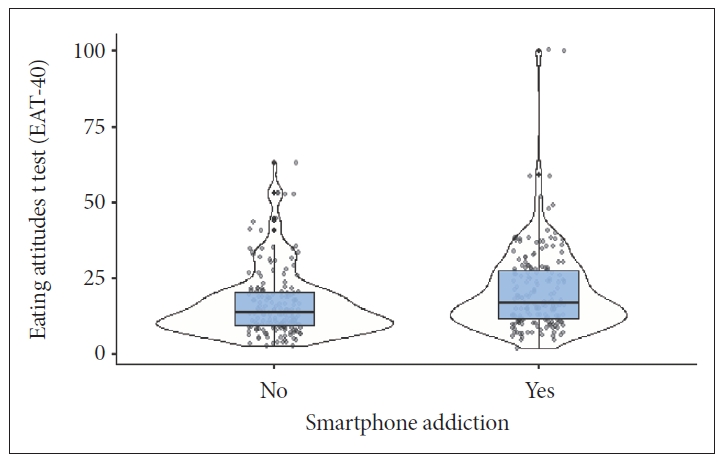 |
 |
- Search
| Psychiatry Investig > Volume 19(1); 2022 > Article |
|
Abstract
Objective
Methods
Results
Conclusion
Notes
Availability of Data and Material
The datasets generated or analyzed during the study are available from the corresponding author on reasonable request.
Conflicts of Interest
The authors have no potential conflicts of interest to disclose.
Author Contributions
Conceptualization: all authors. Data curation: all authors. Formal analysis: ─░brahim G├╝ndo─¤mu┼¤. Funding acquisition: all authors. Investigation: Bahar Ye┼¤il ├¢rnek. Methodology: ─░brahim G├╝ndo─¤mu┼¤. Project administration: all authors. Resources: Bahar Ye┼¤il ├¢rnek. Software: ─░brahim G├╝ndo─¤mu┼¤. Supervision: Bahar Ye┼¤il ├¢rnek. Validation: ─░brahim G├╝ndo─¤mu┼¤. Visualization: Bahar Ye┼¤il ├¢rnek. WritingŌĆöoriginal draft: Bahar Ye┼¤il ├¢rnek. WritingŌĆöreview & editing: ─░brahim G├╝ndo─¤mu┼¤.
Funding Statement
None
Figure┬Ā1.

Table┬Ā1.
| Variable | Total |
Smartphone addiction |
Žć2/Z/T | p value | ||
|---|---|---|---|---|---|---|
| No (N=175) | Yes (N=183) | |||||
| Age (year, mean┬▒SD) | 22.27┬▒3.10 | 22.02┬▒2.70 | 22.51┬▒3.43 | -1.161 | 0.246b | |
| BMI (kg/m2, mean┬▒SD) | 22.34┬▒3.61 | 21.86┬▒3.12 | 22.80┬▒3.98 | -1.984 | 0.047*b | |
| Height (cm, mean┬▒SD) | 170.23┬▒10.23 | 169.97┬▒10.05 | 170.48┬▒10.42 | -0.470 | 0.638a | |
| Weight (kg, mean┬▒SD) | 65.31┬▒14.82 | 63.70┬▒13.64 | 66.85┬▒15.76 | -2.020 | 0.044*a | |
| Gender, N (%) | 0.266 | 0.606c | ||||
| ŌĆā | Female | 214 (59.8) | 107 (50.0) | 107 (50.0) | ||
| Male | 144 (40.2) | 68 (47.2) | 76 (52.8) | |||
| School year (year, mean┬▒SD) | 3.75┬▒1.67 | 3.81┬▒1.51 | 3.70┬▒1.81 | 0.637 | 0.525a | |
| Faculty, N (%) | 12.100 | 0.017*c | ||||
| Medicine-dentistry | 82 (22.9) | 42 (51.2) | 40 (48.8) | |||
| Faculty of science & literature | 167 (46.6) | 94 (56.3) | 73 (43.7) | |||
| Faculty of economics & adm. sciences (FEAS) | 33 (9.2) | 10 (30.3) | 23 (69.7) | |||
| Engineering faculty | 50 (14.0) | 20 (40.0) | 30 (60.0) | |||
| Health sciences | 26 (7.3) | 9 (34.6) | 17 (65.4) | |||
| Family economic status, N (%) | 13.575 | 0.001**c | ||||
| Low | 84 (23.5) | 33 (39.3) | 51 (60.7) | |||
| Middle | 157 (43.9) | 94 (59.9) | 63 (40.1) | |||
| High | 117 (32.7) | 48 (41.0) | 69 (59.0) | |||
| Persons living with, N (%) | 8.942 | 0.030*c | ||||
| Family | 181 (50.6) | 102 (56.4) | 79 (43.6) | |||
| Friend | 77 (21.5) | 29 (37.7) | 48 (62.3) | |||
| Hostel | 74 (20.7) | 32 (43.2) | 42 (56.8) | |||
| Single | 26 (7.3) | 12 (46.2) | 14 (53.8) | |||
Table┬Ā2.
| Total |
Smartphone addiction |
Žć2/Z/T | p value | ||
|---|---|---|---|---|---|
| No (N=175) | Yes (N=183) | ||||
| Age of having first mobile phone (year, mean┬▒SD) | 13.89┬▒2.48 | 13.97┬▒2.44 | 13.81┬▒2.52 | 0.597 | 0.551b |
| Monthly mobile phone invoice, N (%) | |||||
| ŌĆāVery low | 29 (8.1) | 17 (58.6) | 12 (41.4) | 13.412 | 0.004**c |
| ŌĆāLow | 206 (57.5) | 114 (55.3) | 92 (44.7) | ||
| ŌĆāMiddle | 72 (20.1) | 24 (33.3) | 48 (66.7) | ||
| ŌĆāHigh | 51 (14.2) | 20 (39.2) | 31 (60.8) | ||
| Smartphone addiction scale (mean┬▒SD) | 32.34┬▒9.92 | 23.97┬▒5.29 | 40.36┬▒5.85 | -27.744 | Ōēż0.001**a |
| Eating attitude test score (mean┬▒SD) | 18.95┬▒12.66 | 16.75┬▒10.98 | 21.05┬▒13.73 | -3.701 | Ōēż0.001**b |
| Game addiction score (mean┬▒SD) | 10.93┬▒10.41 | 10.08┬▒10.59 | 11.93┬▒10.16 | -1.280 | 0.202a |
Table┬Ā3.
| Smartphone addiction score | Statistics | EAT | Statistics | |
|---|---|---|---|---|
| Underweight (BMI<18.5) (N=33) | 32.57┬▒11.15 | 18.75┬▒9.15 | ||
| Normal Weight (BMI=18.5-24.9) (N=254) | 31.60┬▒0.62 | Žć2=13.434 | 13.32┬▒13.31 | Žć2=7.794 |
| Overweight (BMI=25-29.9) (N=58) | 33.63┬▒8.96 | p=0.004* | 21.77┬▒11.48 | p=0.050* |
| Obese (BMI>30) (N=13) | 40.53┬▒7.72 | 19.15┬▒11.85 |
Table┬Ā4.
REFERENCES








